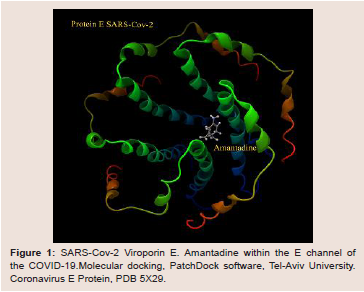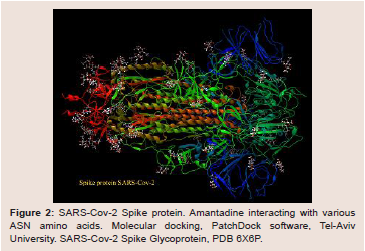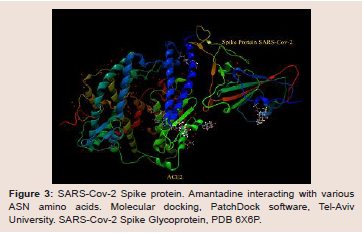Journal of Pharmaceutics & Pharmacology
Download PDF
Review Article
The Sars-Cov-2 Viroporin E and its Interaction with Amantadine an Analysis
Aranda-Abreu GE*, Hernández-Aguilar ME, Herrera-Covarrubias D and Rojas-Durán F
Universidad Veracruzana/Centro de Investigaciones Cerebrales, México
*Address for Correspondence:
Aranda-Abreu GE, Universidad Veracruzana/Centro de Investigaciones
Cerebrales, Xalapa, Veracruz, México; E-mail: garanda@uv.mx
Submission: 14 August 2020;
Accepted: 15 September 2020;
Published: 21 September 2020
Copyright: © 2020 Aranda-Abreu GE, et al. This is an open access
article distributed under the Creative Commons Attribution License,
which permits unrestricted use, distribution, and reproduction in any
medium, provided the original work is properly cited.
Abstract
This article discusses the function of the SARS-Cov-2 virus E-channel
and its interaction with amantadine.In this analysis it is proposed that
amantadine is able to enter the E-channel of the coronavirus, inhibiting
the viral content to enter the cell avoiding viral replication. Therefore,
amantadine is a drug that can help decrease the symptoms of
coronavirus. It is also mentioned how amantadine may be acting with
the Spike protein, through a molecular docking study.
Introduction
At the end of 2019, a new virus called COVID-19 was spreading
in an alarming way in Wuhan City in China. This virus belongs to
the family Coronoviridae and it is structurally formed by 4 proteins,
E and M are part of the viral envelope, N is the one that binds to
the viral genome and S (spike) is the one that binds to the human
receptor ACE2 [1,2].
Aspects of channel E:
Viroporin E structurally consists of 5 protein chains, formed
by 75 amino acids, where 33.33% form an alpha-helix structure
(hydrophobic region), 53.33% random-coil, and 13.33% extended
chain [3,4]. The E protein is well conserved among the 3 corona
virus groups and shows limited homology across the different groups
[5,6]. It has been shown that by deleting the E gene, viral replication
decreases by 100 to 1000 times that of recombinant wild strains and
that this decrease is accompanied by less inflammation in hamster
lungs infected with the virus that possesses the E gene deletion [7].The E protein was mainly located in the Endoplasmic Reticulum-
Golgi Intermediate Compartment (ERGIC) of the cells, where it
participates in assembly, budding and intracellular trafficking,
in addition to possessing ion channel activity [8,9]. Studies have
shown that E is involved in critical aspects of the corona virus life
cycle, which could make it a good candidate for the development of
vaccines or drugs such as amantadine [1,4].
Amantadine molecular function:
Amantadine has been used as an antiviral therapy against the
influenza virus, the proposed mechanism being that it blocks the
early stage of replication. When the viral particle enters the cell, an
endosomal structure is formed which has a pH of 5, this protein
channel is formed by the M2 protein, which carries protons into
the virion. Amantadine by its lipophilic nature is able to cross the
endosome membrane and interrupt the release of the virion into the
cell.Similarly, amantadine can enter the E-channel of the corona virus
by preventing the release of the viral nucleus into the cell [10].
Molecular docking studies have shown that amantadine may interact with the amino acids ALA22 and PHE26 by blocking the
protein channel [4] (Figure 1). A mechanism has also been proposed
where the entry of SARS-Cov-2 into a cell depends on the binding
of the viral spike protein (S) to the cell receptor and the cleavage of
the spike protein by host cell proteases such as Cathepsin L (CTSL)
and Cathepsin B (CATSB). CTSL/B is a crucial element of the
lysosome pathway and both enzymes are found almost exclusively
in lysosomes. The interruption of the CTSL offers a potential
for COVID-19 therapies. Mechanisms of disruption include:
decreased CTSL expression, direct inhibition of CTSL activity, and
impairment of CTSL environmental conditions (increased pH in
lysosomes). Amantadine could reduce the CTSL, further disrupting
the lysosomal pathway and thus interfering with the virus’ ability to
replicate. Amantadine may lower viral load in SARS-CoV-2 positive
patients and, as such, may serve as a potent therapy that decreases
virus replication and infectivity, likely leading to improved clinical
outcomes [11].
Studies have shown that patients with multiple sclerosis,
Parkinson’s disease, or cognitive impairment who were SARS-Cov-2 positive received amantadine or memantine at recommended doses
as part of their therapy, results showed that none developed clinical
manifestations of the disease from COVID-19 [12,13]. This could be
because amantadine could even interact with the Spike protein and
not allow it to bind to the ACE2 receptor (Figure 2 and 3).
Figure 1: SARS-Cov-2 Viroporin E. Amantadine within the E channel of
the COVID-19.Molecular docking, PatchDock software, Tel-Aviv University.
Coronavirus E Protein, PDB 5X29.
Figure 2: SARS-Cov-2 Spike protein. Amantadine interacting with various
ASN amino acids. Molecular docking, PatchDock software, Tel-Aviv
University. SARS-Cov-2 Spike Glycoprotein, PDB 6X6P.
Figure 3: SARS-Cov-2 Spike protein. Amantadine interacting with various
ASN amino acids. Molecular docking, PatchDock software, Tel-Aviv
University. SARS-Cov-2 Spike Glycoprotein, PDB 6X6P.
The lipophilic amantadine, whose chemical formula is C10H17N,
is a derivative of the adamantane whose structure consists of 3
cyclohexane rings. It was approved by the FDA in 1976 for the
treatment of influenza in adults and studied in vitro as a potential
treatment for the SARS epidemic in 2002 [14].
Amantadine is well absorbed orally and well tolerated by the
digestive system, has a moderate diuretic effect and is mainly excreted
unchanged in the urine by glomerular filtration and tubular secretion.
It has a half-life of 10 to 14 h and can generally be given with other
drugs such as antihypertensives and antidiabetics [10].
Conclusion
This pandemic has left at least 500,000 deaths worldwide and it
will still take at least a few more months for an effective vaccine to
become available, leaving a significant gap in infections and deaths.
This is why it is necessary to search for drugs that can help reduce
the effects caused by COVID-19.
Amantadine, because of its characteristics, is emerging as a drug
that can mitigate the effects caused by SARS-Cov-2.




